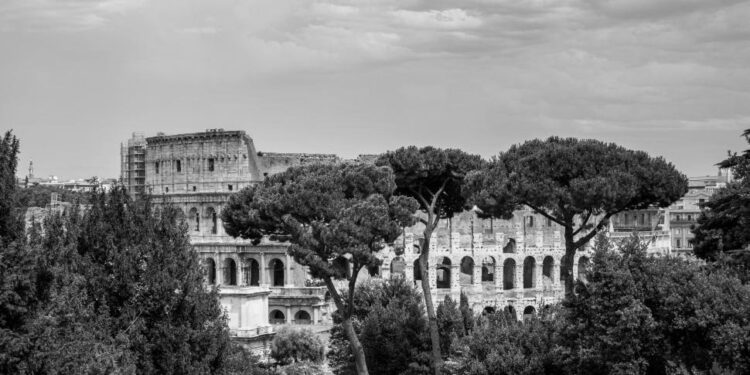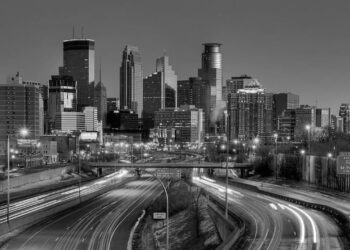How is this possible?
Civilizations have recognized the power of cities to heat themselves up and cool themselves for centuries. City architects in ancient Rome called for narrowing streets to lessen late afternoon temperatures. Narrow streets were found to cool the air by limiting the area exposed to direct sunlight.
The whitewashed architecture of the Greek Isles demonstrates another long-practiced strategy. Light-colored walls and roofs can help cool cities by reflecting incoming sunlight.
In hot and humid regions of the southern U.S., Thomas Jefferson proposed another approach to cooling: Have all new settlements employ a checkerboard pattern of heavily vegetated city blocks interspersed among dense construction. That could promote cooling through convective air movement between cool and warm zones.
As I explore in my recent book, “Radical Adaptation: Transforming Cities for a Climate Changed World,” modern cities unintentionally elevate their own temperatures, creating what is known as the “urban heat island effect.”
How cities heat themselves up
Cities elevate their temperature in four key ways:
- Developers cut down trees to make space for buildings and cars. When tree canopies disappear, that lessens shading and the release of cooling water vapor from leaves via transpiration.
- Urban construction then amplifies the heat. Asphalt, concrete and dark roofing materials all absorb heat from the Sun and heat up the environment around them.
- Absorbed solar energy is compounded by copious amounts of waste heat emitted from industrial processes, vehicle tailpipes and building air conditioning systems.
- In zones of the city occupied by tall buildings, radiant energy released from streets and parking lots is trapped in the concrete canyons, further elevating temperatures.
In combination, these four drivers of the urban heat island effect can raise urban temperatures by 10 to 20 degrees Fahrenheit (5.6 to 11 degrees Celsius) on a hot summer afternoon – a significant, human-driven shift in the weather that can become a serious health risk for anyone lacking air conditioning.
Coupled with the design of the built environment, the natural topography of a city can further accentuate temperature differences from one neighborhood to another. The hills and fog patterns of San Francisco, for example, consistently partition the city’s neighborhoods into distinct climate zones. And the extensive use of yard irrigation systems in hot and arid climates can yield urban temperatures lower than the surrounding desert, sometimes referred to as urban cool islands.
Simple steps for cooling cities down
Understanding the extent to which cities can heat themselves up offers powerful tools for cooling them down as human-driven global warming raises the baseline temperature.
First, it is essential that cities sharply reduce their greenhouse gas emissions to stop fueling the global-scale phenomenon of climate change. Globally, urban areas, with their industries, vehicles and buildings, account for more than 70% of greenhouse gas emissions from energy use, and their populations are growing quickly. Even globally coordinated reductions in greenhouse gas emissions will require many decades to measurably slow warming trends, so cities will still need to adapt.
Cities can also slow the pace of urban heat island-driven warming trends by taking sometimes simple steps. Research shows that the health benefits of urban heat island reduction could be substantial.
At the Georgia Tech Urban Climate Lab, my colleagues and I partner with city governments to estimate the cooling potential of urban heat management – sets of strategies designed to reverse the urban heat island effect. To do this, we measure the direct health benefits of actions such as expanding tree cover and other green infrastructure and using cool materials for roads and roofs.
Our work shows that planting trees across just half of the space available to support tree canopy – such as along streets, within parking lots and in residential yards – could lower summer afternoon temperatures by 5-10 F (2.8-5.6 C), reducing heat-related deaths by 40%-50% in some neighborhoods.
In recognition of these substantial benefits, New York City set and met a goal of planting 1 million trees across its five boroughs.
Cool roofing material and light-colored surfaces can also help lower the temperature. If you wear a black shirt in the Sun on a hot day, you’ll heat up more than if you wear a white shirt. Similarly, light-colored construction materials, roof coatings and shingles will reflect more incoming solar heat than dark ones, and absorb less of that heat. It’s particularly effective in the heat of the day when the Sun’s radiation is strongest.
To leverage this cooling effect, Los Angeles in 2013 became the first major city to require cool roofs on all new homes.
What cities can do now
Aggressive strategies to increase green tree cover across cities, a rapid transition to cool roofing materials, and even replacing some on-street parking lanes and other underutilized impervious areas with bioswales filled with vegetation, can substantially reduce urban temperatures. In so doing, that can increase a city’s resilience to rising temperatures.
Urban heat risk assessments we conducted in numerous U.S. cities, including Atlanta; Dallas; Louisville, Kentucky; and San Francisco, show that a combination of urban heat management strategies could lower neighborhood temperatures by more than 10 F (5.6 C) on hot days and reduce heat-related premature deaths by 20%-60%.
A cooler city is a safer city, and one very much within communities’ power to create.









